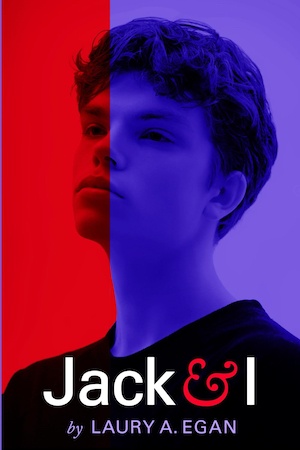
Laury Egan’s new novel, Jack & I, is the dark tale of a 16-year-old New Jersey boy growing up in a state of utter confusion. Part of the turmoil around him is environmental and stems from a succession of foster homes with families of varying mixes of sympathy and exploitation. But most of his confusion is internal. He has undiagnosed and untreated Dissociative Identity Disorder – what used to be called Multiple Personality Disorder.
Sometimes, Jack is his painfully shy and socially inept self but when his alter ego takes over he is brash, aggressive and predatory. The unpredictable emergence of this other Jack (whom I’ll call Jack2 for this review) is one of the reasons foster families don’t keep him for long. This includes the Kennett family, which was the best of the lot, the most supportive, and whose name Jack adopted. Jack’s sexually charged aggression toward the Kennett’s daughter Cara stretched even their compassion too far.
Egan states up-front that her depiction of Dissociative Identity Disorder takes a few liberties for fiction’s purposes but the origin of the condition for people like Jack is usually early childhood trauma. Jack has learned not just to seal off this trauma, he also hides the existence of Jack2. He has only partial memories of what Jack2 gets up to, and sometimes none at all, though he has to bear the punishment and social exclusion that result.
While Jack is a sympathetic character, Jack2 is not, and with a story involving the sexual exploitation of minors Jack and I is a difficult read. Jack2 carries on an illicit liaison with his current foster mother, with the gay hair salon owner in town and with the customers pimped on him by the salon owner. Jack2 is paid for these services and the money is the only aspect of these transactions he’s interested in. The depravity of the adults involved is shocking but Jack2 is completely complicit and expresses profound disdain for Jack, upon whom his whole existence depends.
The shy Jack occasionally finds himself in a frightening situation Jack2 has created, which never goes well. As time and the story go on, Jack2’s behaviour becomes increasingly threatening, but it is Jack who faces the risks and bears the punishment for his transgressions.
Jack doesn’t know how to explain why from one minute to the next his personality changes so radically, and he never tries to. He assumes people will think he’s crazy, because that’s what he thinks. Only when Jack reveals to an understanding high school guidance counsellor the real reason he seems so different at times do you start to perceive there may be a light at the end of the tunnel.
The previous book by Egan reviewed here, The Psychologist’s Shadow, also included a significant psychological component, and she handles this type of issue with great sensitivity. As to the writing, the sections told from Jack’s point of view are in first person and those from Jack2’s perspective are in third person. This is a way to keep absolutely clear which Jack is under discussion, though their different ways of thinking and acting are every bit as powerful a clue. Consequently, the Jack2 sections feel more ‘at a distance,’ as if you’re being told a second-hand story, which makes them less powerful.
Egan also notes that some of the policies and practices of the New Jersey agencies responsible for children and youth services have evolved since the time period of this novel, but she provides a fair representation of the number and types of agencies that would be involved – youth services, the schools, the police, mental health professionals. Relationships among them become complicated and you can’t help but wonder how many of these professionals would take seriously the notion of Dissociative Identity Disorder. One of my greatest anxieties reading the text was that officialdom would dismiss Jack’s diagnosis and instead chalk up Jack2’s bad behaviour to criminality, choosing punishment over healing. But just as you have no problem distinguishing which Jack is responsible for which actions and thoughts, Egan makes sure that the professionals involved who have the chance to observe both personalities recognise the difference too.
It’s a fascinating case study that very much feels grounded in reality, similar to the way Karin Fossum looks at the psychological aspects of criminality in her Inspector Sejer series. Extreme, perhaps, but a reflection of how badly the world treats our most vulnerable and how high are the stakes.
You might also try The Dancer by Óskar Guðmundsson.
Enigma Books
Print, Kindle
£3.99
CFL Rating: 4 Stars